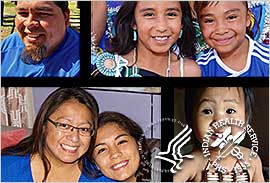Program Spotlights
StoryBraid Videos
During the 2024 SDPI Conference, several SDPI programs participated in 10-minute interviews that consisted of the following questions:
- What has been the greatest impact of the SDPI program in your community?
- How do you know it has been successful? What examples or feedback do you have?
- What aspect of the program has been the most rewarding for you personally or professionally?
The responses to these questions were recorded and made into StoryBraid videos.
Lightning Round Videos
During the 2024 SDPI Conference, a select number of SDPI programs participated in 15-minute presentations that highlighted their diabetes treatment and prevention interventions and outcomes. Programs also shared their chosen Best Practice and other related activities.
SDPI Programs
- MACT Health Board, Inc Diabetes Case Management
- Alamo Navajo Kids in the Kitchen (recorded separately)
- NARA Northwest's Saturday Diabetes Clinics
- Klamath Tribal Health & Family Services
- Fort Berthold Diabetes Prevention
Other Videos
Stories

Quickly jump to a section on this page by clicking on one of the links below.
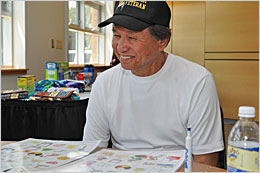
Diabetes Bingo has helped Joseph Good Thunder.
Joseph Good Thunder has been attending Diabetes Bingo at the Lower Sioux Tribe since it started about two years ago. He has diabetes, high blood pressure, and other diabetes complications. He says the diabetes bingo class has helped him.
"I learn something new every time I come here. The repetition helps. I have learned to check my toes and the bottoms of my feet every day to make sure I don't have any ulcers. I check my blood sugar three times a day. I keep a record and bring it with me to my doctor appointments which I go to every three months. I get my eyes checked as my doctor recommends. I have a regiment."
Joseph has cut back on the amount of food he eats, walks 3 – 5 times a week for one hour, and has lost 30 pounds.
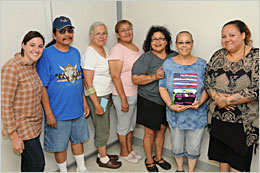
Lifestyle Balance class participants.
The Indian Health Board (IHB) of Minneapolis is one of the largest urban Indian health centers in the Nation. It serves over 3,000 American Indians and Alaska Natives. Two of its classes are funded by the Special Diabetes Program for Indians (SDPI). One class is called Lifestyle Balance and is funded by an SDPI Diabetes Prevention Initiatives grant. The other class is called Diabetes Basics and is funded by an SDPI Community-Directed grant.
IHB Diabetes Program Director Lois Brown, RN, PHN, says a key to being successful when addressing health disparities in urban settings is being flexible to remove barriers. "Transportation can be a barrier, and participants may relocate," explains Lois. "We offer transportation to clinic visits and classes. And for clients who may relocate, we offer courses that can be completed within ten weeks, as well as one-on-one classes."
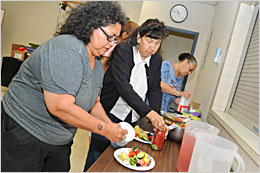
Participants sample healthy meals.
Another key to success is compassion, especially when discussing diabetes complications. "It's common for participants to experience fear, sadness, and depression from memories of family members' complications," explains Lois. These emotions usually surface after a few classes, when participants have built rapport and trust amongst each other. "During the first few classes, people share their knowledge of a connection between sugar and diabetes," says Sammy Gardeen, RD, LD, who teaches the Diabetes Basics class. At about week three, the discussions become more personal. "Participants start opening up. They share their own stories of how diabetes has affected their lives."
During a week four Diabetes Basics class, the topic was complications: heart attacks, comas, and amputations. There was shock and sadness in the room, as well as silence and a few tears. One participant broke the silence by wondering aloud what he should do. He put his head in his hands, clearly distraught. Sammy set her notes down. "When you are feeling overwhelmed, don't be afraid to get counseling, go for a walk, or call a friend." One woman said, "But I'm all alone," and another participant quickly replied, "You've got us."
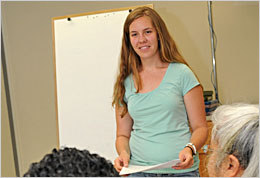
Diabetes Basics teacher Sammy Gardeen.
Offering heartfelt support and a sense of unity is another key to success. "We let people voice what is in their hearts. We hear each other out," explains Sammy. "Our staff are not the only teachers. Our participants teach each other and us, as much as we ever teach them."
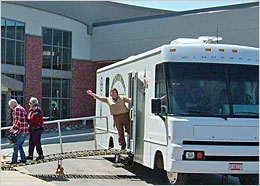
White Earth Podiatry Clinic on Wheels.
The White Earth Reservation is the largest in the state of Minnesota, encompassing over 1,000 square miles and serving about 11,000 people through its IHS health clinic. When its diabetes program first received SDPI Community Directed Program funding in 1999, staff could not envision where they would be in 13 years. At the time there was only one small fitness center serving the entire tribe and no podiatrist. Today the program has implemented numerous activities to support its Physical Activity and Foot Care Best Practices. "We have an excellent diabetes prevention and management program. We are on track," said LaRaye Anderson, Diabetes Program Coordinator.
There are diabetes fitness centers offering free personal training at four of the tribe's villages. Clients can work out with trainers or participate in group classes of Zumba® fitness, kick boxing, kettlebell, pole walking, step aerobics and boot camp fitness. Several 5K run/walks and regular blood sugar, A1C, blood pressure and kidney screenings are offered each year. Diabetes program staff collaborate with other programs to offer healthy snacks and schedule the 5K run/walks at the same time as community gatherings like powwows.
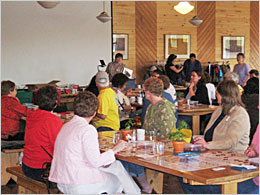
Healthy Living Bingo session.
Healthy Living Bingo is held monthly in each village. About 40 adults and children attend each month and learn how to prevent diabetes – how to attain healthy blood pressure, cholesterol and blood sugar numbers, how to eat healthy using My Plate and the importance of regular physical activity. Diabetes Bingo, which focuses on preventing diabetes complications, is also held monthly in each village. About 25 people attend and learn how to prevent diabetes complications by managing their blood sugars, taking medications as prescribed and keeping medical appointments.
In fitness centers and community gathering rooms, brightly colored posters of Aimee Smith, a young White Earth fancy shawl dancer, decorate the walls. Diabetes program staff developed the poster with the words "White Earth Dancing to Defeat Diabetes." Staff also developed a logo featuring a cyclist, a runner and a traditional dancer accompanying the phrase "Exercise is medicine."
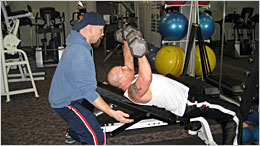
White Earth Diabetes Program member lifting weights.
A podiatry surgeon travels to villages in a mobile clinic giving foot checks and handing out breathable socks, orthotics and special shoes, a direct result of the tribe's diabetes program implementing the Foot Care Best Practice. "We were concerned with the lack of a podiatrist and the high number of amputations, so we chose the Foot Care Best Practice to address this," said LaRaye. "In the ten years since the tribe has contracted with the podiatry surgeon, amputations have decreased and awareness has increased on the importance of preventing ulcers and maintaining good foot care."
Diabetes staff evaluates activities by gathering assessments and evaluations. GPRA (Government Performance Results Act) numbers and diabetes audit information allow staff to assess the program's impact. On one fitness program evaluation form, a client wrote what she accomplished after only two months: "I can put on my own socks and shoes. I can fasten my seat belt. I have been able to stop taking two medications, saving me $170 each month!"
Another client reported: "In one year, I lost 150 pounds! I am walking without my walker and started gardening again. I feel responsible for my health and have faith in myself."
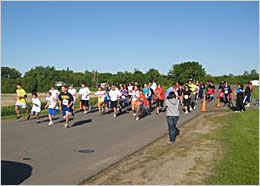
White Earth Diabetes Program members participating in a 5K walk.
Many clients have commented that the professional, helpful staff is key to learning about diabetes prevention and management. "They are kind to all who walk through the fitness center doors," said a client.
Although many community members have lost weight, obesity and overweight continue to be a challenge at White Earth. "We are building on what we have learned," says LaRaye. "It takes empathetic, professional and energetic staff, which we have. And it takes time, so we are working now with our sights on future goals. The obesity and overweight numbers are challenges that face everyone in the United States. I feel we are on the right path in educating our people and offering opportunities to participate in fitness no matter what a person's fitness level or interests are."
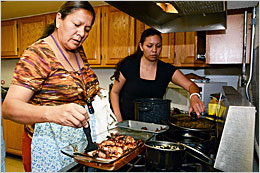
Woman glazing baked pack rat.
More members of the San Carlos Apache Tribe are trying traditional foods like cholla (cactus) buds, acorn dumplings, pack rat, and quail -- thanks to the Traditional Western Apache Diet Program. The White Mountain Tribe, Tonto Apache Tribe, and Yavapai-Apache Nation are also participating in the program. The goal of the program is to analyze the pre-reservation Western Apache diet. It is a first step in encouraging tribal members to return to a more traditional diet.
To expand awareness and support, three San Carlos Apache Tribal staff prepared a special lunch for Tribal Chairman Terry Rambler and his staff. “We want to get more support from the Tribe by reconnecting people to traditional foods and Mother Earth. This food heals your body,” explained Department of Forest Resources Staff Twila Cassadore.
Twila and Health Educator Daylene Anderson created the menu of pico de gallo with cholla buds, spinach salad with currants and pine nuts, acorn dumpling and elk soup, quinoa topped with baked quail, baked pack rat glazed with agave, mini whole wheat fry bread topped with zucchini, corn, and tepary beans, blue corn crepes stuffed with cream cheese and prickly pear, and fresh squeezed lemonade with chia seeds. Most dishes represented what Western Apaches ate before reservations were created. No sugar, salt, or white flour was used.
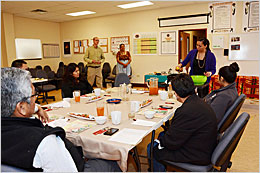
People sitting at lunch table.
Twila had been gathering seeds for weeks. Twila and her family members had also spent days hunting pack rat and quail. Twila and Daylene were up early that day to prepare the meal.
When Chairman Rambler and four staff entered the room and sat down, Twila and Daylene brought out the first course, pico de gallo topped with cholla buds, served with blue corn chips. The guests started sampling right away. Immediately, the conversation focused on the past. “My grandma used to catch catfish, huge ones. We used to wrestle them out of the water,” recalled Chairman Rambler.
While guests sampled additional dishes, Seth Pilsk, Department of Forest Resources Staff, talked about the program. “We want to get the Apache diet back to the community. Not because it’s healthy, but because it’s super-healthy.”
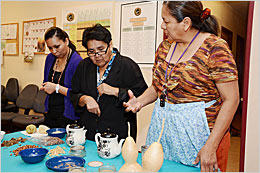
Three women looking at traditional food.
He explained that the program has identified over 200 harvestable foods on San Carlos Apache land. A nutritionist is analyzing the diet, and discovering that it is indeed super-healthy – high in healthy fats, and low in saturated fat and cholesterol. “We have also found that it is very high in fiber,” said Seth.
After the meal, guests gathered around a table displaying seeds, nuts, flours, and celery root. Guest Kevin Cassadore said, “We are learning our culture, the roots of who we are. We can say, ‘We are Natives and this is the kind of food we eat.’”
In the weeks following the lunch, Traditional Western Apache Diet Program staff began weekend outings to teach tribal members how to identify and gather traditional foods.
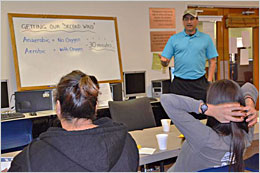
Tucson Indian Center class about benefits of exercise.
Every Wednesday morning a group of Native people from a variety of tribes gathers at the Tucson Indian Center for camaraderie, a healthy snack, diabetes prevention information, and a walk. This is not a round-the-block stroll: It's a brisk walk of over two miles.
On one Wednesday morning, Diabetes Prevention Program Coordinator Arcenio Trujillo sets out coffee, yogurt and bananas, and writes "Getting Our Second Wind" in big letters on the white board. Clients enter this downtown Tucson building, help themselves to snacks and coffee, and get caught up with friends.
This is the Tucson Indian Center Walking Group. They have been meeting for about two years. When the group first started, there was one walker. Now there are up to 20 walkers.
Erolinda Ramon, Tohono O'odham Nation, has been walking with the group for several months. "It's friendly. Arcenio is a good speaker," she explains.
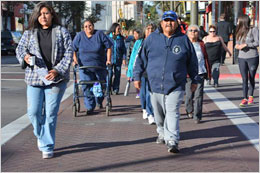
Native group walking in downtown Tucson.
Today Arcenio is using long words: anaerobic and aerobic. He writes the words on the white board. Before anyone's eyes can gloss over, he explains that when you keep your heart rate up for over 30 minutes, the body enters an aerobic, fat burning state. When your body switches from anaerobic to aerobic, it is getting its second wind.
"It's like your body goes from easy listening to heavy metal music. It's like it runs out of quick fuel, but doesn't panic because there is stored fat to burn. It's like your body starts burning the delicious bacon!" says Arcenio.
The clients can't help but envision their bacon being burned. They laugh. They know they will be walking for over an hour, at a quick pace.
The start of the walk is a warm up. The group waits at several corners for stoplights, then picks up the pace. They turn left, and start climbing steps. Hearts are pumping strongly as they cross the Snake Bridge, walk through the mouth of the snake, then out the tail. There's an automatic rattling sound as the walkers exit the tail.
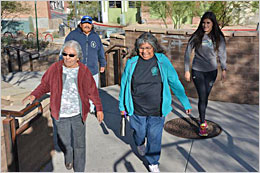
Native walkers climbing steps.
The second bridge is called the Basket Bridge, beautifully made to look woven. The group zips across it, does a ritualized turn around, and heads back. At this point, they have been walking over 30 minutes. Each walker can visualize the bacon melting away.
Back at the Tucson Indian Center, Isabella Enriquez, Tohono O'odham Nation, checks her pedometer. "It says 5,208 steps! Two point eight miles," she says. Arcenio explains that, while walking this distance is good, all walking will help prevent and manage diabetes. "Park farther away. Walk fast to the store. Get out of the bus one stop before your stop and walk the rest," he suggests.
Erolinda listens to Arcenio. "He cares about the way we live, and wants us to improve our health. I've learned a lot from him."
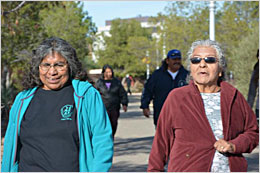
Two Tucson Indian Center women walkers.
Native people living in and near Tucson, Arizona, are finding a way to become fit, or keep their fitness regimens going strong. Once a week they can join a walking group held at the Tucson Indian Center in downtown Tucson.
Both Isabella Enriquez, Tohono O'odham Nation, and Erolinda Ramon, Tohono O'odham Nation, started regular walking about two years ago. Isabella was in the Center's Lifestyle Balance class when she joined the walking group. For a while she was the only client in the group. She walked the over 2-mile course with the Diabetes Prevention Program Coordinator, Arcenio Trujillo.
"She would show up even when it was freezing cold!" recalls Arcenio.
Erolinda started walking when she was in the SDPI Healthy Heart Program at the San Xavier Health Clinic. She has diabetes, and, at that time, had severe pain in her feet. "I've had a hard time controlling my diabetes. But the walking helps me," she says.
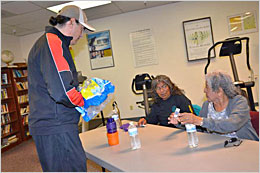
Tucson Indian Center staff and clients.
Erolinda has lost weight, no longer needs insulin shots, and eats more fruits and vegetables and fewer sweets. "My blood sugar has come down and I've been feeling real good," she says.
Isabella walks up to seven miles a day. She has become stronger and improved her balance. She has lost weight, and eats more fruits and vegetables and less high-fat food. She cut back on soda and drinks more water.
These lifestyle changes have helped Isabella feel better. "At one time, I couldn't even move. But now I don't feel pain so much. I don't feel depressed. I don't have diabetes. I'm 67, and feel like I'm getting younger!"
Every week Isabella and Erolinda join the Center's walking group, which has grown from one participant to about 20. The two women have made regular walking a part of their lives.
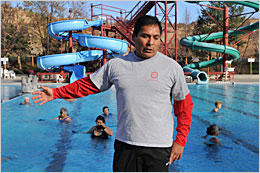
Edmund Francis teaching water aerobics.
Montell Elliott, the Diabetes Prevention Program Coordinator at the Warm Springs Tribe located in Central Oregon, says participants are in the "call to action" phase of diabetes prevention and management. The tribe has both an SDPI Diabetes Prevention (DP) program and a Community-Directed program, which makes it possible to offer many activities aimed at helping community members increase physical activity and lose weight. The reason the offerings are full of participants is because the grants have been able to build on initial stages. "Native communities have seen grant programs come and go," explains Montell, "but the SDPI programs have been here for nearly 12 years."
She says the first years were spent addressing the" fatalistic" belief many of her clients had about diabetes. "Many believed that they would automatically get diabetes, that there was nothing they could do," recalls Montell. For several years, program activities focused on teaching that diabetes could be prevented or delayed. Montell says the program staff is still teaching the Lifestyle Balance 16-week diabetes prevention curriculum, and now participants are believing the information and acting on it.
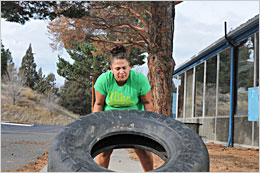
Christel Leonard in the Functional Fitness class.
The SDPI program staff is ready for the "action phase" with a number of weight loss and physical activity classes including:
- Lifestyle Water Aerobics which is led by Edmund Francis and Jeri Kollen and held in a huge, hot-spring-fed pool.
- Diabetes Prevention that helps participants stay motivated and deal with setbacks to healthy lifestyle changes, develop and monitor weight loss plans and sample healthy snacks like low-fat cheese and bean burritos.
- Functional Fitness that is super-tough and motivates participants to keep heart rates up by exercising for one minute at multiple "stations" including a semi-tire-flipping station.
- Senior Fitness where seniors ages into their 90s do low-impact exercises involving cardio, strength training and Zumba®.
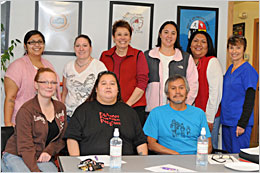
Diabetes Prevention Program Class.
Weight loss results are coming in. Many DP program participants have lost weight and gained muscle. Edmund Francis, who participated in the DP program in 2007, comes from a family in which both parents have histories of cardiovascular disease and diabetes. Because of what Edmund learned in the DP program, he has limited processed foods and eliminated the consumption of alcohol. He does not have diabetes. Now Edmund is the Tribal Wellness Coordinator.
Another community member, Anna Hurtado (Warm Springs), attends water aerobics and a fitness class. She has diabetes and has recently lost about 15 pounds. She says her legs hurt sometimes, but it's a good hurt. "They get sore because I'm exercising them," she says. Anna is 74 years old.
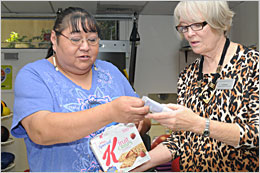
Two women at the Denver Indian Health and Family Services discussing how to lose weight and practice diabetes self care.
It's a typical morning for Allene Stanley (Cheyenne River Sioux). By ten AM she has walked over 1400 steps -- some of them up a hill to get more of an aerobic workout. She has eaten a small orange instead of drinking a glass of orange juice. She has not even thought of having a "Diet Dew" because all soda is gone from her house. Just seven weeks ago, Allene started her days differently. Her eating habits weren't as good and daily exercise was not a habit. But she has been attending the Denver Indian Health and Family Services (DIHFS) program Fork n' Road once a week for almost two months and has changed many of her eating and exercise habits.
Diabetes Program Manager Kathy Canclini, MN, RN, CDE, and other staff of this urban clinic started the program, funded by the Special Diabetes Program for Indians (SDPI) Community Directed Grant Program, in January 2010. The clever name, Fork n' Road, reflects the program's focus of making better lifestyle choices by improving eating habits (fork) and increasing exercise (road) to lose weight and prevent or manage diabetes.
"We had a 91 percent obesity rate," explains Kathy. "The Best Practice we chose was Weight Management. We were inspired by the Best Practice and we used the Division of Diabetes Treatment and Prevention's Balancing Your Life and Diabetes curriculum."
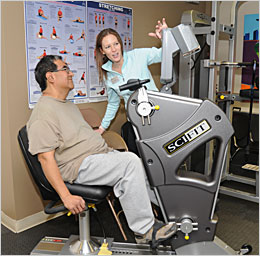
DIHFS staff member showing a client how to use exercise equipment.
Like most urban Indian clinics DIHFS has a client population with characteristics common to Natives living in big cities, diversity being the most prominent. "I would guess that 80 to 90 percent of tribes are represented among our clients, from Native Hawaiians, to Alaska Natives, to members of tribes in Maine" says Kathy. Many of the center's clients do not have health insurance. Some are travelling and some live in Denver for a while, then move.
DIHFS staff view these challenges as positives. "Our clients appreciate meeting other Native people. They appreciate how we sincerely care for them, how we slow things down, taking time to provide many hours of diabetes education classes, as compared to two hours at non-Indian hospitals or clinics. They appreciate how we honor and respect their values."
The foremost value among their clients is family. Diabetes Prevention Specialist Kristen Curcija, MPH, says, as a non-Indian, she has learned a lot about the values of her Native clients. "I have learned how much they value their families and how our teaching has a ripple effect throughout their families. Everyone is so open and sharing. We hear their heartbreaking stories of how diabetes has impacted their cousins, their aunties. After listening, I started to understand the enormity of the love and care our clients have for each other."
In addition to learning about values, staff have learned what works to put on a successful weight loss program at their urban Indian clinic. Here are some of their tips:
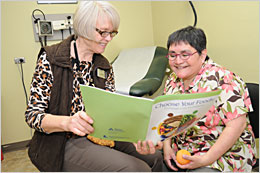
DIHFS staff member reviewing Choose Your Foods: Exchange Lists for Diabetes with a client.
- Use a team approach involving all staff from the clinic and the diabetes program. "The clinic refers patients to us, and we refer clients to the clinic" says Kathy. "We establish a relationship with the clinic patients and they are more likely to come to our classes."
- Develop a program name, logo. Think creatively to name your program and develop your logo – have fun with it! Use the logo on materials to foster an identity for your program. You are welcome to borrow the name and logo Fork n' Road if it will help you market your program.
- Consider creating a contract for staff and clients to sign at start of classes. The DIHFS Fork n' Road Program Behavior Contract includes the statement: I promise to enjoy myself during class.
- Include interactive activities. While waiting for other clients to arrive participants play catch with an inflated "Weight Loss Toss-Up Ball", which has nutrition and exercise questions printed on it. Participants are encouraged to provide the answers.
- Repetition helps. Staff never assume clients know information about nutrition, like how to read labels. They teach, then teach again as needed -- repetition works!
- Expect and celebrate the small changes clients make, like switching from whole milk to skim milk, being able to decrease medications (as ordered by the provider) due to weight loss, wearing smaller-sized clothing, walking around a park and eating more fruits and vegetables. "We are delighted when our clients make eating habit changes and even more excited when we see them smiling, laughing, and feeling better about themselves" says Lorraine Gill, RD, MA, CDE.
- Be delighted by your clients' huge successes, like dramatic drops in A1C, LDLs and lower BMIs. Some DIHFS clients' A1Cs have dropped from 14 percent to under 7 percent!
- Evaluate to show clients' successes. During the first and last classes, clients complete a form developed by the DIHFS Diabetes Program called "Assessment and Evaluation of Healthy Behaviors". Participants give themselves a rating from "rarely" to "regularly" (1-5 Likert scale) regarding nutrition and exercise habits. For Best Practice outcome grant reporting, staff compare before and after class scores. In the last class staff use the SDPI In Review, which asks participants to assess their current habits to show them how much progress they have made and what changes they need to focus on in the future.
- Conduct follow-up assessments. At six and 12 months after the program, clients are re-evaluated for weight, BMI, body measurements and Healthy Behavior Ratings. Again, the team celebrates and/or re-motivates the participant with ongoing support.
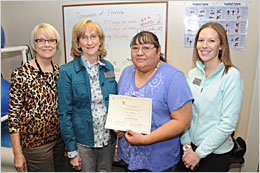
DIHFS staff members posing with a successful Fork n' Road Weight Management Program client.
When clients finish the Fork n' Road Program they are presented with a certificate of graduation and are then eligible to join the Crossroads Program, which focuses on the rest of the Diabetes Self-Management Education. Crossroads is a program primarily offered to clients with diabetes, although all are welcome to attend. Staff chose not to do separate classes for those with diabetes and those without diabetes because nutrition, exercise and behavior change education is applicable to all.
SDPI Grantee Showcase Webinars
Learn about SDPI program successes from grantees. Contact the SDPI Team regarding any issues. These webinars do not offer CME/CE credit.
-
SDPI Showcase: Cheyenne and Arapaho Tribes’ Mobile Medical Unit: Bringing Services to the Patient
Presenters: Marcos Baros, Cheyenne and Arapaho Tribes Diabetes Wellness Program Director
Kayla Thompson RN, Clinic Nurse Manager
Duration: 47 minutes
Presentation Handout:
- Slides [PDF – 1.3 MB]
-
Sac and Fox Nation of Oklahoma - BlackHawk Health Center Archery Tag Exercise
Presenter: Anthony Ramirez, Exercise Specialist
Duration: 43 minutes
Presentation Handout:
- Slides [PDF – 2.1 MB]
-
Southcentral Foundation’s Integrated SDPI Team
Presenters: Katey Redmond, MPH, CPH
Elize Rumley, RD, LD, MS, PhD, CDCES, BC-ADM
Louis Melchor, B.S., M.A.T., CHC
Velda Miller, M.Ed , CGFI , ICCE, NBC-HWC
Scott Hadley, MS, certified exercise physiologist from ACSM
Duration: 58 minutes
Presentation Handout:
- Slides [PDF – 2.6 MB]
-
Saginaw Chippewa’s Continuous Glucose Monitors CGMs and Insulin Pump
Presenters: Sandi Chesebrough, LPN
Tammy House, RN, CDCES, WCC
Duration: 1 hour 2 minutes
Presentation Handout:
- Slides [PDF – 1.7 MB]
-
Tulalip and the ADA Native American Curriculum, “What Can I Eat”
Presenters: Veronica Leahy, DCCC
Howard Johnson,
PharmD, BC-ADM
Duration: 56 minutes
Presentation Handout:
- Slides [PDF – 3.8 MB]
-
Gallup Service Unit Diabetes Care and Education Program (DMP)
Presenter: Aimee Reinhard, Pharm D
Duration: 37 minutes
Presentation Handout:
- Slides unavailable
-
Choctaw Nation of Oklahoma and the Diabetes Prevention Program
Presenter: Lee Ann Sherrill, RN, CDE
Duration: 50 minutes
Presentation Handout:
- Slides [PDF – 1.2 MB]
-
What’s Cooking? Cooking Programs and Other Activities from Alamo Navajo and Taos Pueblo
Presenters: Laura Hartung MA, RDN, LD
Chris Aloia, MPH
Duration: 57 minutes
Presentation Handouts:
- Taos Slides [PDF – 2.5 MB]
- Alamo Navajo Slides [PDF – 4 MB]
-
Meet the Tucson Area SDPI Grantees
Presenters: Kevin Fortuin
Veronica Boone, MSW
Victoria C. Ramirez
Duration: 58 minutes
Presentation Handouts:
- Tohono O’odham Slides [PDF – 3.2 MB]
- Tucson Indian Center Slides [PDF – 2 MB]
- Pascua Yaqui Slides [PDF – 1.3 MB]
-
Alaska Native Tribal Health Consortium: Diabetes Program Virtual Health Aide Course and Alaska Blanket Exercise (ABE)
Presenters: Teresa Hicks, RD, CDCES
Panikaa Teeple, BSW
Luz Smeenk, MS, RD
Duration: 53 minutes
Presentation Handouts:
- Virtual Education for Community Health Aides Slides Diabetes [PDF – 921 KB]
- Alaska Blanket Exercise Slides [PDF – 1.0 MB]


